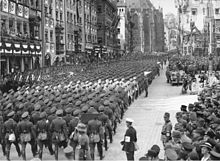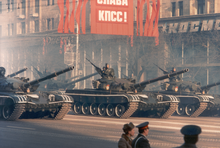militarism

As militarism is domination of military values and interests in the political and social life designated as such by the one-sided emphasis on the law of the jungle and the idea wars were necessary or unavoidable, expressed or through a strictly hierarchical , on command and obedience- based thinking.

Definitions and models
According to the political scientist and militarism researcher Wilfried von Bredow , militarism, which he describes as “the dominance of the military as an organization in state and society” and which includes “the predominance of military-warlike categories of thought in the state, society and politics”, is “two different Models for the civil-military relationship "that developed after the industrial revolution:


- In the first model, the armed forces are not of great importance in “everyday social life”, they remain “virtual” and only “in the event of a threat” do they become “topical”: “In a military emergency, it appears to the citizens as a patriotic duty to put on uniform and defend their state . ”According to von Bredow, this model can lead to militarism, but does not have to. In the case of the USA, "the weapon cult that can be traced back to this model in civil life could be described as a shrunken form of militarism".
- In the second model, the armed forces themselves are the “engine of general social development”. The armed forces are regarded as the “school of the nation” and intervene massively in political decision-making processes even in so-called peacetime: “Military values and soldiers' behavior determine civilian actions and decision-making processes”. This model basically promotes militarism. Von Bredow cites German militarism under Kaiser Wilhelm II as a historical example of this (see also subsection military in the article German Empire ).
Not only, but also with a view to the National Socialist tyranny, Antony Joseph Coates characterizes militarism as "a frequently occurring tendency or a cultural prejudice in favor of war that a war leader can fall back on". In this form, “militarism first causes wars and then dictates their ruthless implementation”. According to Art. III of the Control Council Directive No. 38 , militarists were among those burdened by the Nazi regime and were to be denazified in court proceedings .
According to the German military historian and peace researcher Wolfram Wette , one criterion for a non-militaristically oriented state is that it requires its soldiers to refrain from "obeying an order that includes an offense or crime". A refusal to obey is, for example, acc. Section 22 (1) sentence 1 of the WStG is not punishable in Germany if a criminal act would be committed by following an order.
history

Again and again, entire societies have been shaped by a long-lasting militarization that encompasses many areas of society (e.g. Sparta ). In the German cultural area, militarism formed an important social phenomenon from the 18th to the end of the 20th century. Since the early modern period, the forced recruitment of mercenaries or compulsory military service when building up standing armies in the Protestant countries of Europe has led to a strong militarization. Emmanuel Todd points out that the younger sons in Protestant societies, which were organized according to the principle of the ancestral family (the eldest son inherits the farm and lives with the parents, the younger sons go largely empty), are “instruments of a true militarization of society ”. The possible solution of changing to a monastery in Catholic countries remained closed to them. At the height of militarization under Louis XIV around 1710, Catholic France only had an army strength of 1.5% of the population, whereas in Protestant Prussia in 1740 it was 3.7% and in 1760 7.1% due to the recruitment of non-inheriting sons. In Protestant Sweden, 7.7% of the population was in military service in 1709, and in Hessen-Kassel, which lent its soldiers to the British during the American War of Independence, the militarization rate also reached 7.7%. England was an exception among the Protestant states: Here the nuclear family dominated early on, in which the farmers as tenants were not fixed on the land and the inheritance status of the children was not fixed, and the recruitment rate reached its maximum in 1710 at only one percent; it fell to 0.3% by 1783.
Also of nationalism , a side effect of militarization was created in Protestantism: "Every Calvinist people who read the Bible, holds at any time for a new chosen by God of Israel." Later, was Lutheranism into a vehicle for militarization of German society . Before the First World War, Ernst Troeltsch noticed that Lutheranism was "combined [...] with the reaction of monarchical thought, agrarian patriarchalism, the military instincts of power" and thus gave the "restoration ideal and ethical support". It was therefore "supported by the socially and politically reactionary powers with all means of violence, sanctified the realistic sense of power and the ethical virtues of obedience, piety and a sense of authority that are indispensable to Prussian militarism."
literature
- Volker Berghahn : Militarism. The story of an international debate (“militarism”). Verlag Berg, Hamburg 1981, ISBN 3-608-91479-X .
- Wilfried von Bredow: Military and Democracy in Germany: An Introduction (Study Books Foreign Policy and International Relations). VS Verlag, Wiesbaden 2007, ISBN 978-3-531-15712-2 .
- Stig Förster : The double militarism. The German military armament policy between securing the status quo and aggression 1890–1913 (= publications of the Institute for European History Mainz. Vol. 118). Steiner, Stuttgart 1985, ISBN 3-515-04310-1 .
- Tomohide Ito : Militarism of the civilian in Japan 1937-1940: Discourses and their effects on political decision-making processes (series on the history of Asia; Vol. 19). Iudicium Verlag, Munich 2019. ISBN 978-3862052202 .
- Wolfgang Kruse: The Invention of Modern Militarism. War, the military and civil society in the political discourse of the French Revolution 1789-1799 . Oldenbourg Verlag, Munich 2003, ISBN 3-486-56684-9 (plus habilitation thesis, University of Hagen 2001).
- Christoph Schubert-Weller: "No more beautiful death ..." The militarization of male youth and their commitment in the First World War 1890–1918 . Juventa-Verlag, Weinheim 1998, ISBN 3-7799-1127-2 .
- Wolfram Wette (Ed.): School of violence. Militarism in Germany; 1871-1945 . Aufbau-Taschenbuch-Verlag, Berlin 2005, ISBN 3-7466-8124-3 .
- Wolfram Wette: Militarism in Germany. History of a warlike culture . Fischer Taschenbuch, Frankfurt am Main 2011. ISBN 978-3-596-18149-0 (first edition Wissenschaftliche Buchgesellschaft Darmstadt 2008).
Web links
- Youth in Germany 1918 to 1945: Militarism before 1933 (NS Documentation Center of the City of Cologne)
- Bettina Musall: Militarism in the Empire . In: One day , June 14, 2013
Individual evidence
- ^ Schubert, Klaus / Martina Klein: Das Politiklexikon . 4th, updated Bonn: Dietz 2006.
- ^ Wilfried von Bredow: Military and Democracy in Germany: An Introduction (Study Books Foreign Policy and International Relations). VS Verlag, Wiesbaden 2007, p. 66 f.
- ^ A b Coates, AJ: The Ethics of War , Manchester: Manchester University Press 1997. ISBN 0-7190-4046-9 , p. 40.
- ↑ Wolfram Wette: Militarism in Germany. History of a warlike culture . Fischer Taschenbuch, Frankfurt am Main 2011, p. 222.
- ↑ Emmanuel Todd: Sad Modern Age. Munich 2018, p. 183.
- ↑ Todd 2018, p. 184.
- ^ Ernst Troeltsch: The social doctrines of the Christian churches and groups. Tübingen 1912. Reprint Aalen 1961, p. 603; newly published in: Ernst Troeltsch: Critical Complete Edition , KGA 9 / 1–3, ed. by FW Graf, Berlin 2015.
